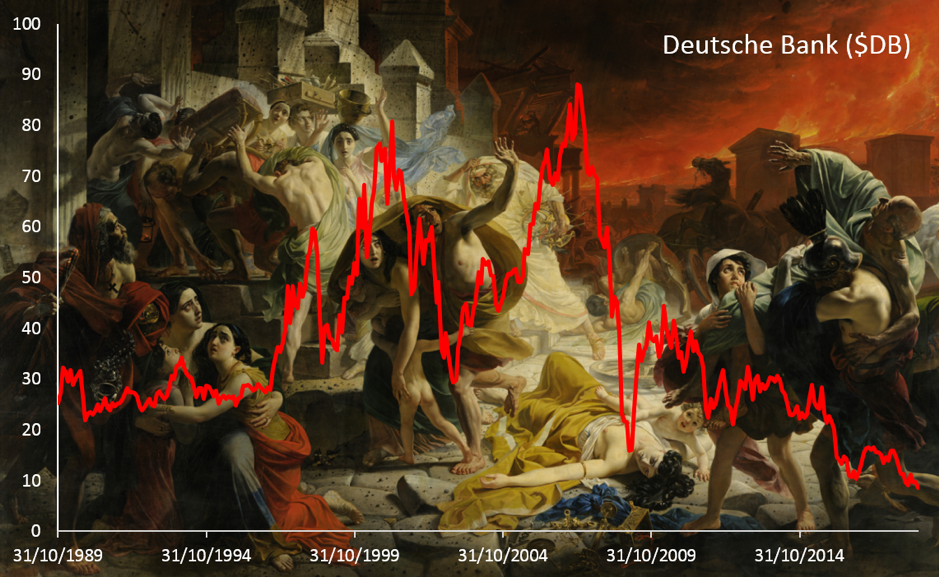… like a circle in a spiral, like a wheel within a wheel,
Never ending or beginning on an ever spinning reel…– “Windmills of Your Mind”, Alan and Marilyn Bergman (1968)
Our old friend the doom loop is back in the news, having gained a spot in the Bank of England’s (BoE) financial stability report. We’ve detailed this phenomenon in past issues of Capital & Conflict – on the assumption that sovereign debt is risk free, European banks have bought huge quantities of their own government’s debt. The fates of European banks and their governments are now tied together, as a decline in the value of government debt will lead to problems for the banks, while a decline in the banks will lead to problems for the government.
But the doom loop situation gets gloomier, for when it begins to do damage, other countries are affected too. From the BoE’s financial stability report, emphasis mine:
A further deterioration in Italy’s financial outlook could result in material spillovers to the euro area and the UK.
Following market tensions in May, Italian government bond yields rose again in October, to their highest levels since early 2014. The rise was linked to the new Italian government’s publication of a draft budget, which envisaged a fiscal loosening, reversing the previous tightening policy. If implemented, this would have adverse implications for Italian public debt, which, at 130% of GDP, is already high.
Italian banks hold a significant proportion of Italian public debt, and greater perceived sovereign risk has spilled over to measures of [Italian bank] riskiness, raising [Italian bank] funding costs. Further increases in funding costs, if passed on to households and businesses, could depress already weak growth, leading to an increase in non-performing loans (NPLs). Italian NPLs account for a quarter of all euro-area NPLs.
Although direct UK banking exposures to Italy are low, if financial strains were to spread across the euro area, there could be a material risk to UK financial stability. UK-owned banks have much higher claims on countries with close links to Italy, including France (63% of CET1) and Germany (74%).
CET1 is common equity tier one –a bank’s core capital. If that gets wiped out, it’s bailout time…
My colleague Nick Hubble has been ringing the bell on the Italian Problem well before the media caught wind of it – if you want to find out how he predicts this will all play out, you should have a read of his book.
An insider at Deutsche Bank spills the beans
On the topic of bailouts and non-performing loans, we return to Deutsche Bank, which may need the former to cure the latter. As detailed yesterday, this global systemically important bank is plumbing near 30-year lows:
Click image to enlarge
To get a better understanding of Deutsche’s position and just how dangerous its failure would be, I asked John Butler, a former managing director at the bank.
John had an illustrious career in investment banking before becoming disillusioned with the fiat monetary system and turning to gold. His latest venture is the Lend & Borrow Trust Company, which allows businesses and individuals to borrow at low cost with their precious metals holdings – you can read more on that here.
His thoughts on Deutsche’s woes were intriguing:
Given the much larger size of DB’s balance sheet, its sudden failure would be almost certain to roil German, European and global financial markets to an even greater extent than Lehman’s failure did. It is thus difficult to imagine that the German government would not step in to rescue and restructure it in some way, presumably with a huge amount of taxpayer-backed capital.
However, as this would violate the EU’s and ECB’s post-crisis rules about direct national assistance for failing banks, it would open up a general euro-area can of worms in which Italy, Spain, France and probably all euro member countries would seize the precedent as an opportunity to part-nationalise their own respective banking systems.
As this would imply soaring national debt issuance requiring de facto monetisation in some form by the ECB, it would certainly spell the end of the euro as we know it and the possible re-emergence of national parallel currencies. Indeed, this is now such a distinct possibility I would be surprised if any euro-area participating government were not now actively preparing contingency plans. Naturally, these would be kept as closely guarded state secrets unless and until their implementation were actually needed in a crisis scenario.
There’s trouble downriver. With that in mind, it’s no wonder my colleague Eoin Treacy is gearing up to start shorting the stragglers in the market. I need to ask him if he has Deutsche in his sights…
Until next time,

Boaz Shoshan
Editor, Capital & Conflict
Category: The End of Europe


